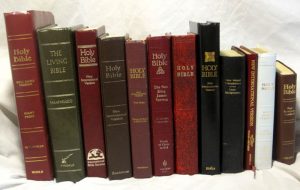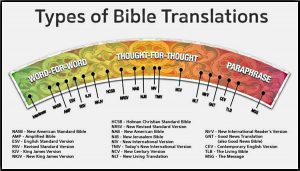
-
Save
Translation resembles a sliding scale with each translation placed somewhere between the two opposite ends. On one side of the scale are the literal translations, on the other the dynamic. The literal strives to achieve exact rendering of the original language with minimal concern for readability or modern idioms. The dynamic end of the scale attempts to provide a readable and easily understood text even if it moves away from the literal rendering of the original language. It attempts to relay the meaning more than the literal terminology.

-
Save
An extreme example is the New World Translation of the Jehovah’s Witnesses which subverts the nature of Christ through translation. The RSV renders John 1:1 “In the beginning was the Word, and the Word was with God, and the Word was God.”
Teaching that Jesus Christ was a creature, and not the eternal Son of God, the Jehovah’s Witnesses translate the passage to conform to their heresy. Their New World Translation renders John 1:1 as, “In the beginning the Word was, and the Word was with God, and the Word was a god” although the article “a” is absent from the original Greek text.
Many Protestant translations display a considerable doctrinal persuasion, even a bias against Catholicism….



This Post Has 2 Comments
Steve, I understand what you are trying to get at. But on another Catholic Apologists website, I commented on the Catholic Confraternity Version of the New Testament translating these passages similar to the NIV. In both 2 Thessalonians 2: 15 and 3: 6, it translates “traditions” as “teachings.” In fact, in Corinthians 11: 2, the TNIV and the 2011 revision of the NIV both translate it as “traditions” with no footnote, while the Confraternity Version has it as “precepts”; the 1984 NIV has “teachings” with “or traditions” in the footnote; and in both 2 Thessalonians 2: 15 and 3: 6, it has a footnote stating “or tradition[s]”. I do not believe that a solid case can be made that the NIV is part of a conspiracy to eliminate Catholic doctrine on tradition – if so, why do the footnotes offer the possible rendering, “traditions”? Also, the very conservative Protestant New American Standard has “works” in James 2: 24 in both its last 2 releases. I think the issue is that the NIV is using its typically dynamic method of translation, and is not trying to doctor the text of Scripture!
Another point is that the Confraternity Version also rejects the directly Marian interpretation of Revelation 12: 1. Protestant translation and exegesis is not some sort of bogeyman trying to keep Protestants in the dark about the “real meaning” of Scripture, a charge many of them make towards Catholics as well. (Btw, I am a Catholic who loves apologetics).
Peter your comment is well-intentioned but mistaken. Go back to Gregory Martin and the “discovery of the manifold corruptions of scripture…“ And you will see that’ from the very beginning of the reformation especially in England, the texts were adulterated and corrupted to try to falsify doctrine. This was after all the whole reason for the creation of the Douay Rheims translation in the first place. Numerous passages can be brought forward to show this, but the best thing is for you to look online for Gregory Martin’s great work.
There you will find corruptions of the text which required Gregory Martin’s work, which concern nearly every doctrine of Catholicism that the protestants tonight. It is a beautiful work.
But this doesn’t answer one of your basic questions. You seem to think that because Catholic translations have the same adulteration, this shows that that is no protestant conspiracy to defraud the faith. Actually, it shows the conspiracies great success. In many cases modern Scripture Scholar‘s in the 20th century went right along with the corrupt passages and the poor translations, 10 Gentges ones at that. It is only at the time of John Paul the second that you start to see the need for a change to go back to the original texts and the original understandings of the text.
We’ll all be interested what you find!
Dr. Dom
14058347506
pedullad@outlook.com
Comments are closed.